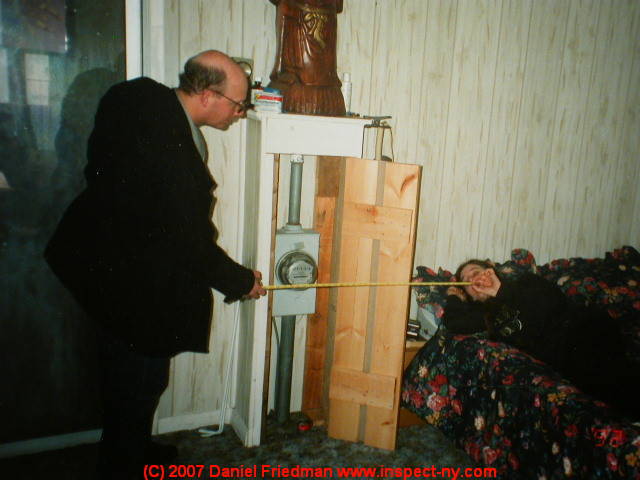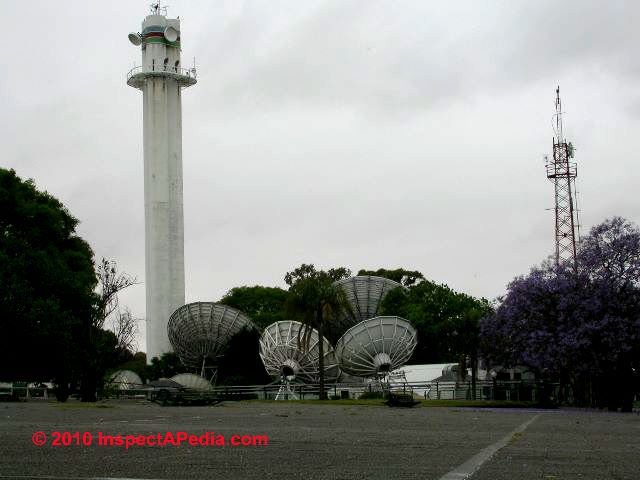 Definitions of Hertz, Kilohertz, Megahertz, Gigahertz, Terahertz
Definitions of Hertz, Kilohertz, Megahertz, Gigahertz, Terahertz
Frequency measures
- POST a QUESTION or COMMENT about definitions of frequency measurements: hertz, kilohertz, megahertz, gigahertz, terahertz and cycle counts
Definitions of Hertz, Kilohertz, etc.
This article defines and compares frequency measurements expressed in Hertz, Kilohertz kHz, Megahertz mHz, Gigahertz gHz, and Terahertz tHz .
Our page top photo illustrates measuring the distance between a hidden electric meter and the head of anyone lying in an adjacent bed.
While the field strength of an EMF around an electric meter or service entry cable falls off very quickly, one can indeed measure a strong field when quite close to the equipment.
InspectAPedia tolerates no conflicts of interest. We have no relationship with advertisers, products, or services discussed at this website.
- Daniel Friedman, Publisher/Editor/Author - See WHO ARE WE?
Table of Definitions of Kilohertz, Megahertz, Gigahertz, Terahertz
 Relation of wavelength to frequency & speed: notice that the shorter the wavelength the higher the frequency.
Relation of wavelength to frequency & speed: notice that the shorter the wavelength the higher the frequency.
That's why in our table above as the wavelengths get smaller (notice those negative exponents?) the electromagnetic frequency numbers get larger.
More technically, wavelength is inversely proportional to wave frequency.
Do not confuse wavelength and frequency of an electromagnetic wave with its speed.
All electromagnetic waves move at or close to the speed of light (and do move at the speed of light if measured in a vacuum).
The speed of an electromagnetic wave, expressed in meters per second is equal to wavelength (in meters) x frequency (in oscillations per second or Hertz, abbreviated as Hz).
Photo: cell towers and other electrical devices and antennae in Buenos Aires, Argentina.
- Hertz - Hz is defined as the number of cycles per second of any oscillating or repeating phenomenon, but usually used to define electrical signals, or electrical field frequencies such as those of electromagnetic fields, radio signals, or computer processing clock cycles.
The term Hertz as used in frequency measurement was named for German physicist Heinrich Hertz (1857-1894), who studied electromagnetism, clarified Maxwell's electromagnetic theory of light, and demonstrated the existence of electromagnetic waves.
The term Hertz was established by the International Electrotechnical Commission in 1930. - Kilohertz - kHz is defined as thousands of cycles per second. Synonyms for kilohertz found in some documents include kc, kilocycle, kilocycles per second.
- Megahertz - mHz is defined as millions of cycles per second - 1000 x more than kilo. See our table below.
- Gigahertz - gHz is defined as billions of cycles per second - 1000 x more than mega, or 1,000,000,000 cycles per second - Microwave towers, UHF and EHF transmission - operate in the 1GHz to 100GHz range.
- Terahertz - tHz is defined as trillions of cycles per second- Wavelengths at frequencies still higher than EHF - GHz are referred to as Terahertz radiation, but are more
familiarly understood as infrared light.
Still higher frequencies become light visible to the human eye. One THz is a very high frequency unit of electromagnetic (EM) wave frequency equal to one trillion hertz (10-to-the-12th power Hz)
Our table (below) provides definitions of various frequencies or oscillation rates expressed in kilohertz, megahertz, gigahertz, or terahertz.
| Frequency Definitions | Frequency in words | Frequency in Exponent Form |
|---|---|---|
Definition of Hertz Hz |
One Hertz - one cycle per second | 10-1 |
Definition of Decahertz daHz |
Tens of cycles per second | 101 |
Definition of Hectohertz hHz |
Hundreds of cycles per second | 102 Not in common use |
Definition of Kilohertz kHz |
One kilohertz - one thousand cycles per second = 1,000 | 103 |
Definition of Megahertz mHz |
One megahertz - one million cycles per second = 1,000,000 | 106 |
Definition of Gigahertz gHz |
One gigahertz - one billion cycles per second = 1,000,000,000 | 109 to 1012 (range) |
Definition of Terahertz tHz |
One terahertz - one trillion of cycles per second = 1,000,000,000,000 | 1012 to 1015 (range) |
The additional Hertz incredibly-high frequencies listed below are not likely to be found in use describing electromagnetic radiation such as those discussed in these articles - these are not in common use, but may be used to describe quantum-mechanical wave functions.
Definition of Petahertz pHz |
One petahertz - one followed by 15 zeros, or more formally, One petahertz pHz = 1 x 1015 [cycles per second if we are discussing frequency] |
1015 |
|---|---|---|
Definition of Exahertz eHz |
One exahertz - one followed by 18 zeros, or One eHz = 1 x 1018 |
1018 |
Definition of Zetahertz zHz |
One zetahertz -one followed by 21 zeros, or One zHz = 1 x 1021 |
1021 |
Definition of Yotahertz yHz |
One yotahertz - one followed by 24 zeros, or One yHz = 1 x 1024 |
1024 |
Separately at TABLE of EMR FREQUENCIES we provide a separate listing of the frequency in Hertz of various sources of electromagnetic radiation, ranging from ULF - ultra low frequency sources - through UHF - ultra high frequency electromagnetic radiation sources.
Because the possible effects of electromagnetic fields on humans, other animals, and even materials varies significantly by frequency (and wavelength, distance, and other factors).
Thank you to our readers for their generous comments
Thank you ever so much for your explanation about the difference between MilliGauss and Hertz. On 2016-03-29 by Kandi Thank you
Reply by (mod) - Thanks Kandi. Don't hesitate to ask if you find any InspectApedia.com article unclear - working together makes us smarter. Daniel
...
...
Continue reading at ELECTROMAGNETIC FIELD EMF ELF & RF DETECTION or select a topic from the closely-related articles below, or see the complete ARTICLE INDEX.
Or see DEFINITIONS of HERTZ, KHz MHz GHz THz FAQs - questions and answers about frequency definitions posted originally at the end of this article.
Or see these
Recommended Articles
- CELL PHONE RADIATION
- DEFINITIONS of EMF RF FIELD & FREQUENCY
- DEFINITIONS of HERTZ, KHz MHz GHz THz
- ELECTROMAGNETIC FIELD EMF ELF & RF DETECTION
- EMF ELECTROMAGNETIC FIELDS & HUMAN EXPOSURE
- ENVIRONMENTAL HAZARDS at BUILDINGS - home
- RF RADIO FREQUENCY DETECTION METERS
Suggested citation for this web page
DEFINITIONS of HERTZ, KHz MHz GHz THz at InspectApedia.com - online encyclopedia of building & environmental inspection, testing, diagnosis, repair, & problem prevention advice.
Or see this
INDEX to RELATED ARTICLES: ARTICLE INDEX to BUILDING ENVIRONMENT
Or use the SEARCH BOX found below to Ask a Question or Search InspectApedia
Ask a Question or Search InspectApedia
Questions & answers or comments about various hertz definitions. .
Try the search box just below, or if you prefer, post a question or comment in the Comments box below and we will respond promptly.
Search the InspectApedia website
Note: appearance of your Comment below may be delayed: if your comment contains an image, photograph, web link, or text that looks to the software as if it might be a web link, your posting will appear after it has been approved by a moderator. Apologies for the delay.
Only one image can be added per comment but you can post as many comments, and therefore images, as you like.
You will not receive a notification when a response to your question has been posted.
Please bookmark this page to make it easy for you to check back for our response.
IF above you see "Comment Form is loading comments..." then COMMENT BOX - countable.ca / bawkbox.com IS NOT WORKING.
In any case you are welcome to send an email directly to us at InspectApedia.com at editor@inspectApedia.com
We'll reply to you directly. Please help us help you by noting, in your email, the URL of the InspectApedia page where you wanted to comment.
Citations & References
In addition to any citations in the article above, a full list is available on request.
- "San Francisco Law Will Make Cellphone Retailers List Radiation Rate", Jesse McKinley, The New York Times, 16 June 2010 p. A14.
- Questions and Answers about Biological Effects and Potential Hazards of Radiofrequency Electromagnetic Fields [PDF] Federal Communications Commission, Office of Engineering and Technology, US FCC, OET Bulleting 56, 4th Edition, August 1999
Many consumer and industrial products and applications make use of some form of electromagnetic energy.
One type of electromagnetic energy that is of increasing importance worldwide is radiofrequency (or "RF") energy, including radio waves and microwaves, which is used for providing telecommunications, broadcast and other services.
In the United States the Federal Communications Commission (FCC) authorizes or licenses most RF telecommunications services, facilities, and devices used by the public, industry and state and local governmental organizations.
Because of its regulatory responsibilities in this area the FCC often receives inquiries concerning whether there are potential safety hazards due to human exposure to RF energy emitted by FCC-regulated transmitters.
Heightened awareness of the expanding use of RF technology has led some people to speculate that "electromagnetic pollution" is causing significant risks to human health from environmental RF electromagnetic fields.
This document is designed to provide factual information and to answer some of the most commonly asked questions related to this topic." - original source: U.S. Federal Communications Commission Office of Engineering and Technology, http://www.fcc.gov/Bureaus/Engineering_Technology/Documents/bulletins/oet56/oet56e4.pdf - "Evaluation of Potential Carcinogenicity of Electromagnetic Fields," EPA Report #EPA/600/6-90/005B October 1990. EPA: 513/569-7562.
- "Biological Effects of Power Frequency Electric and Magnetic Fields" background paper, prepared as part of OTA's assessment of "Electric Power Wheeling and Dealing: Technological Considerations for Increasing Competition," prepared for OTA by Indira Nair, M. Granger Morgan, H. Keith Florig, Department of Engineering and Public Policy, Carnegie Mellon University, Pittsburgh, PA 15213
- "Biological Effects of Power Line Fields," New York State Powerline Project. Scientific Advisory Board Final Report, July 1, 1987.
- "Extremely Low Frequency (ELF) Fields," Environmental Health Criteria 35. World Health Organization, Geneva, 1984.
- "Electric and Magnetic Fields at Extremely Low Frequencies: Interactions with Biological Systems. In: Non ionizing Radiation Protection, World Health Organization, Regional Office for Europe, Copenhagen, 1987.
- "Electric and Magnetic Fields from 60 Hertz Electric Power: What do we know about possible health risks?," Department of Engineering and Public Policy, Carnegie Mellon University, Pittsburgh, PA 15213 1989.
- "Electromagnetic Fields Are Being Scrutinized for Linkage to Cancer," Sandra Blakeslee, New York Times, Medical Science section, April 2, 1991
- In addition to citations & references found in this article, see the research citations given at the end of the related articles found at our suggested
CONTINUE READING or RECOMMENDED ARTICLES.
- Carson, Dunlop & Associates Ltd., 120 Carlton Street Suite 407, Toronto ON M5A 4K2. Tel: (416) 964-9415 1-800-268-7070 Email: info@carsondunlop.com. Alan Carson is a past president of ASHI, the American Society of Home Inspectors.
Thanks to Alan Carson and Bob Dunlop, for permission for InspectAPedia to use text excerpts from The HOME REFERENCE BOOK - the Encyclopedia of Homes and to use illustrations from The ILLUSTRATED HOME .
Carson Dunlop Associates provides extensive home inspection education and report writing material. In gratitude we provide links to tsome Carson Dunlop Associates products and services.

